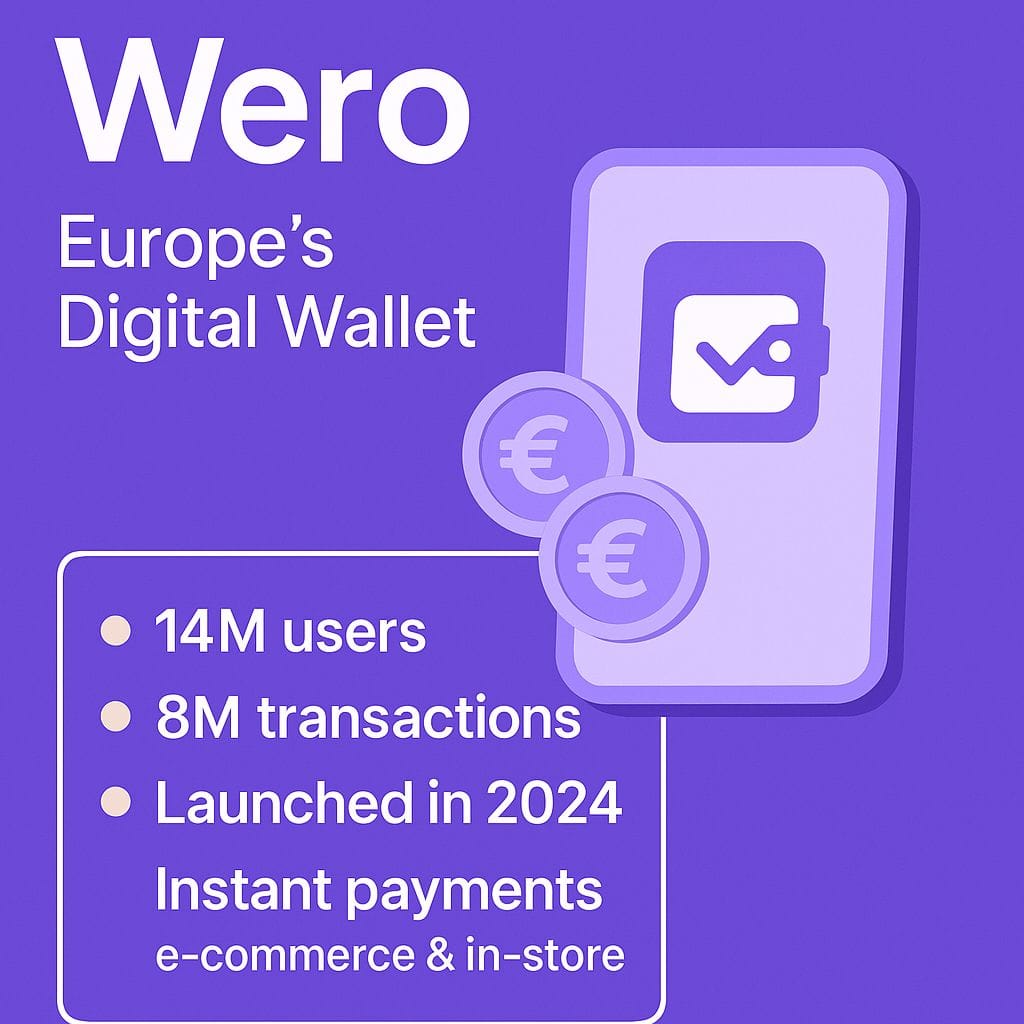Wero by the Numbers
Wero was introduced in July 2024 as the official wallet of the European Payments Initiative (EPI). The initiative is backed by a powerful consortium of European banks and payment providers, including BNP Paribas, Deutsche Bank, DZ Bank, ING, Société Générale, UniCredit, and Worldline. This institutional backing ensures that Wero is not just another fintech experiment but a strategic project to unify Europe’s fragmented payment landscape and reduce reliance on global schemes like Visa, Mastercard, and PayPal.
By the end of 2024, Wero had reached 14 million users and processed more than 8 million transactions in its first three markets: Germany, France, and Belgium. In early 2025, Belgian banks expanded support, and Wero announced plans to reach 40 million registered users within the year. With launches in the Netherlands and Luxembourg expected during 2025, the wallet is on track to become one of Europe’s most significant new payment solutions.
Innovation at Wero
Wero is built on instant account-to-account transfers, allowing consumers to pay directly from their bank account without intermediaries. Early adoption has focused on peer-to-peer payments, where users send or receive money using only a phone number or email. This removes friction and builds consumer familiarity.
Innovation is central to Wero’s roadmap. Beyond P2P, Wero is introducing e-commerce checkouts with QR code support and preparing for in-store contactless payments by 2026. Its long-term vision also includes responsible BNPL, recurring billing models, and loyalty and rewards services. This combination of features positions Wero not just as a wallet, but as a fully-fledged European alternative to Visa, Mastercard, and PayPal.
Roadmap and Product Suite
Wero is designed as a multi-product wallet that evolves step by step. Each stage expands its usefulness for both consumers and merchants.
-
Current stage (2024–2025): Peer-to-peer transfers across Germany, France, and Belgium, with e-commerce pilots in Germany and France.
-
Next stage (2025): Expansion into Luxembourg and the Netherlands, alongside broader e-commerce adoption.
-
Future stage (2026): In-store POS acceptance, recurring billing, BNPL integration, and loyalty features.
This gradual rollout ensures Wero can build user adoption while delivering new value to merchants at each phase.
Where Wero Works
Wero is already active in several European markets and expanding further.
| Country | Live Products |
|---|---|
| Germany | P2P transfers, e-commerce pilot |
| France | P2P transfers, e-commerce pilot |
| Belgium | P2P transfers, expanded bank participation |
| Luxembourg | Launching in 2025 |
| Netherlands | Launching in 2025 |
By 2026, Wero expects to add additional EU countries along with in-store and subscription support.
Why Merchants Should Care
Higher approval rates
Card transactions often fail due to insufficient funds, incorrect details, or issuer restrictions. With Wero, payments move directly between bank accounts, bypassing many of the weak points that cause declines. This results in consistently higher approval rates, which is especially critical for all industries where every successful transaction has a measurable impact on revenue. Merchants adopting Wero can expect a smoother payment flow and fewer lost sales.
Reduced fraud and chargebacks
Fraudulent activity and chargebacks cost merchants both money and time. Wero’s account-to-account framework ties every transaction to verified bank details, making fraud attempts far harder to execute. By cutting out card numbers and reducing reliance on intermediaries, merchants gain a payment method that is naturally more secure. Fewer disputes and chargebacks mean lower operational risk and more predictable margins when scaling online.
Support for recurring billing
Subscriptions, memberships, and SaaS platforms depend on payment reliability. Failed renewals not only reduce revenue but also damage customer relationships. Wero’s roadmap includes recurring billing support, which will allow merchants to process renewals directly from consumer bank accounts. This reduces churn, increases lifetime value, and provides a foundation for stable long-term growth across industries that depend on recurring payments.
Consumer trust
Adoption depends on confidence, and Wero benefits from being created by Europe’s largest financial institutions, including BNP Paribas, Deutsche Bank, and ING. Consumers are more likely to trust a wallet backed by the same banks where they already hold accounts. For merchants, offering Wero at checkout is a way to leverage that trust, reduce cart abandonment, and show customers a familiar, bank-approved payment option.
How Fasto Helps
Fasto integrates Wero into its broader suite of local payment methods, including Klarna, Swish, MobilePay, Bizum, and Pix. Our platform makes it easy for merchants to adopt Wero while managing all payment flows through a single dashboard.
FastoPayments is also equipped with tools that go beyond integration. We provide fraud protection, chargeback monitoring, recurring billing support, and approval optimization features such as BIN-level routing and tokenization. These ensure that Wero does not just work, but performs at its best for your business model.
💡 Interested in learning more about what’s included in a typical high-risk merchant account? View our complete breakdown of FastoPayments’s high-risk merchant accounts.




